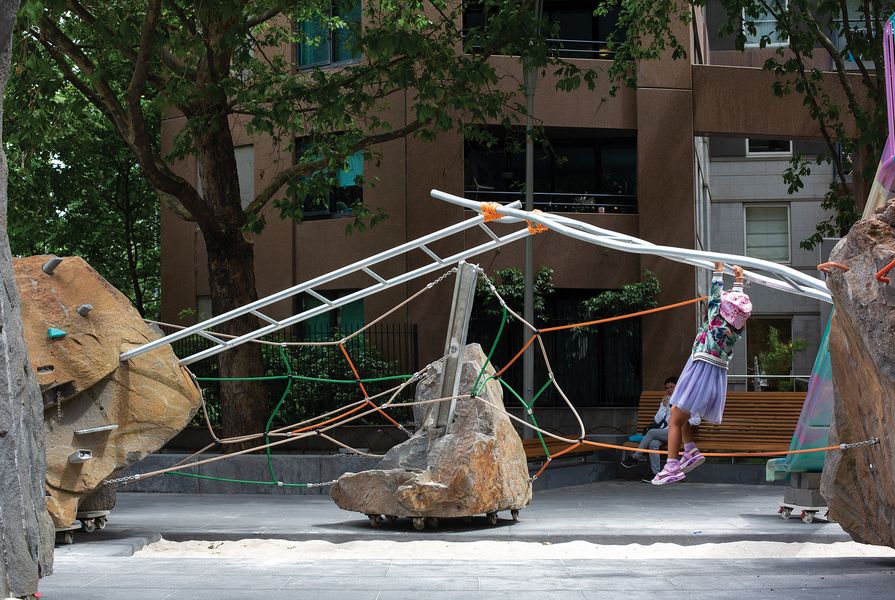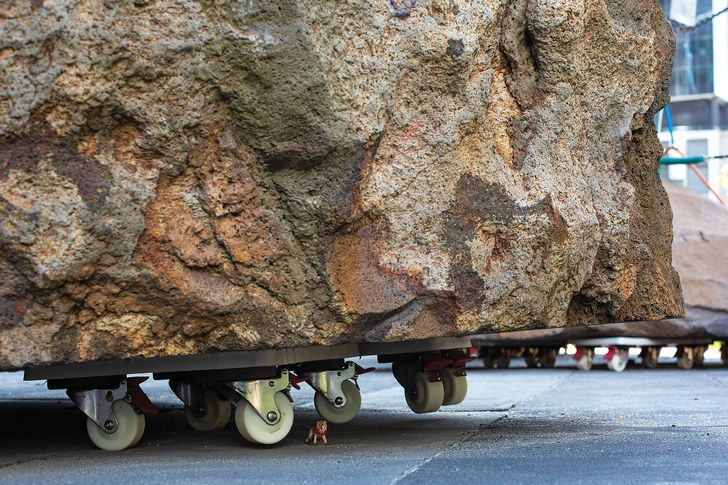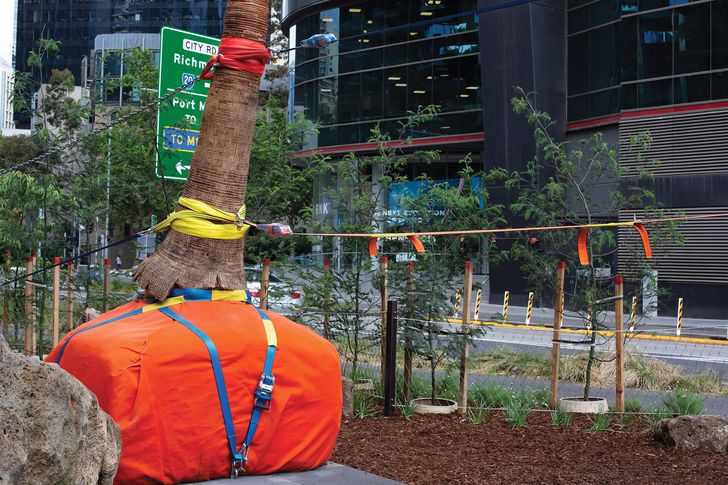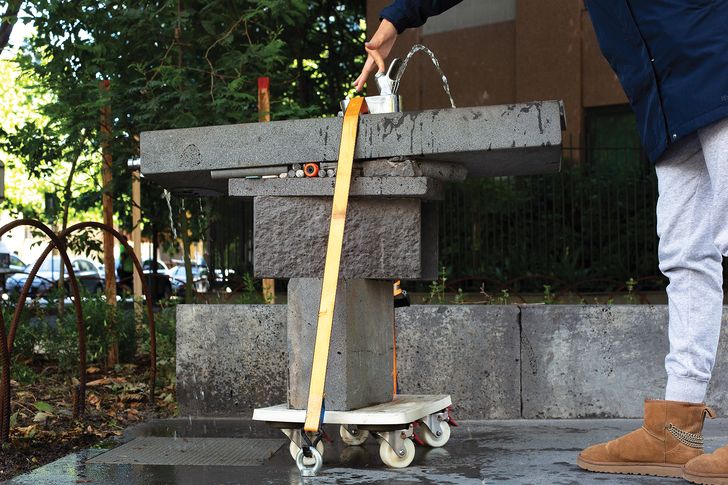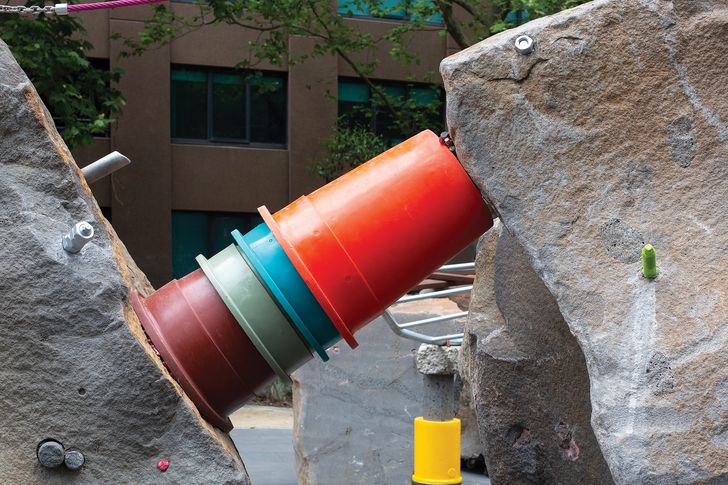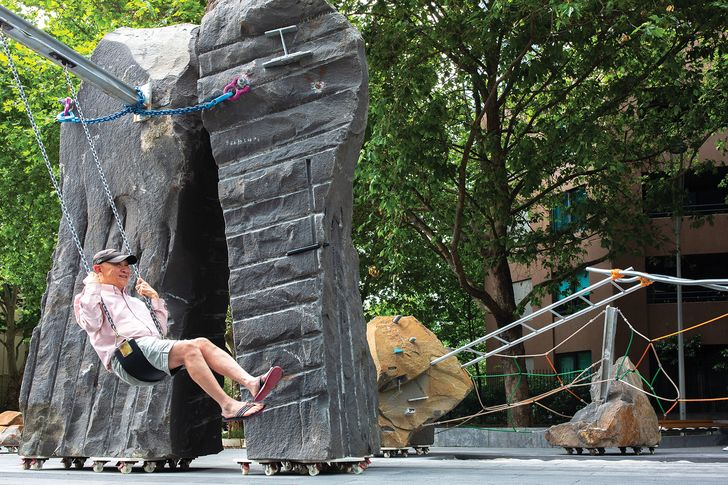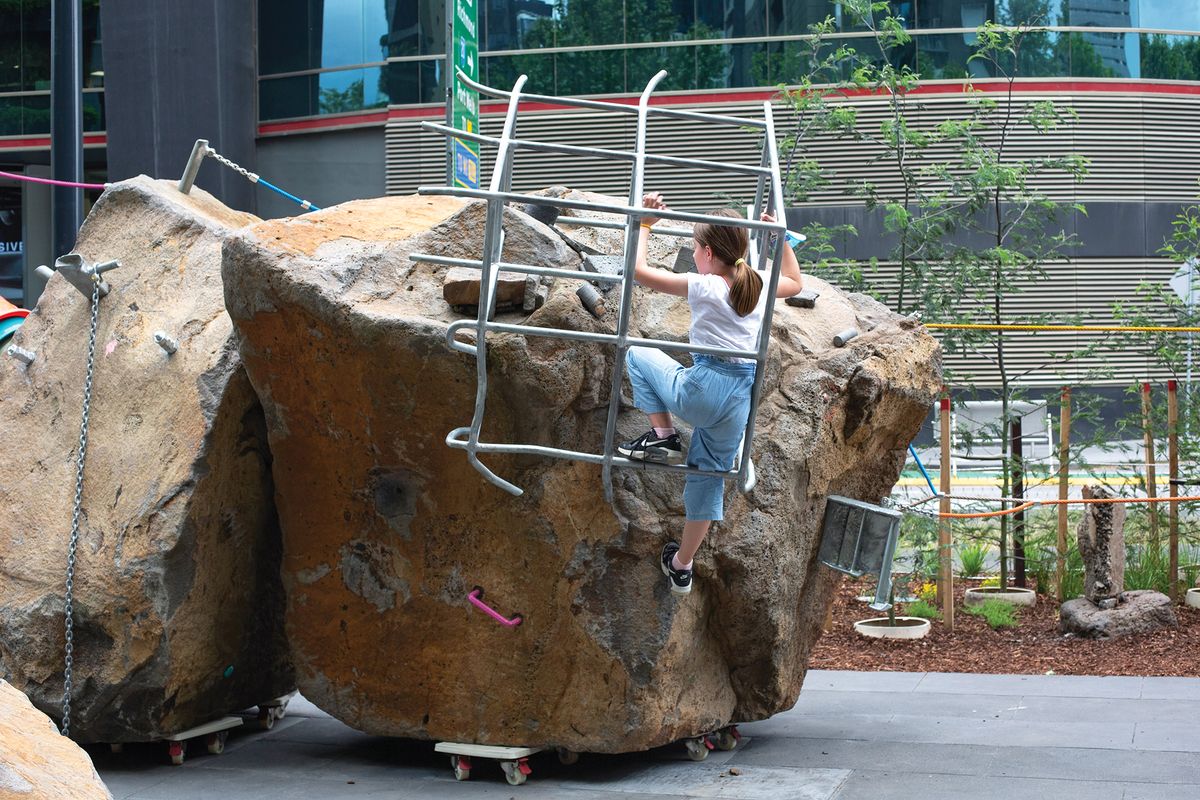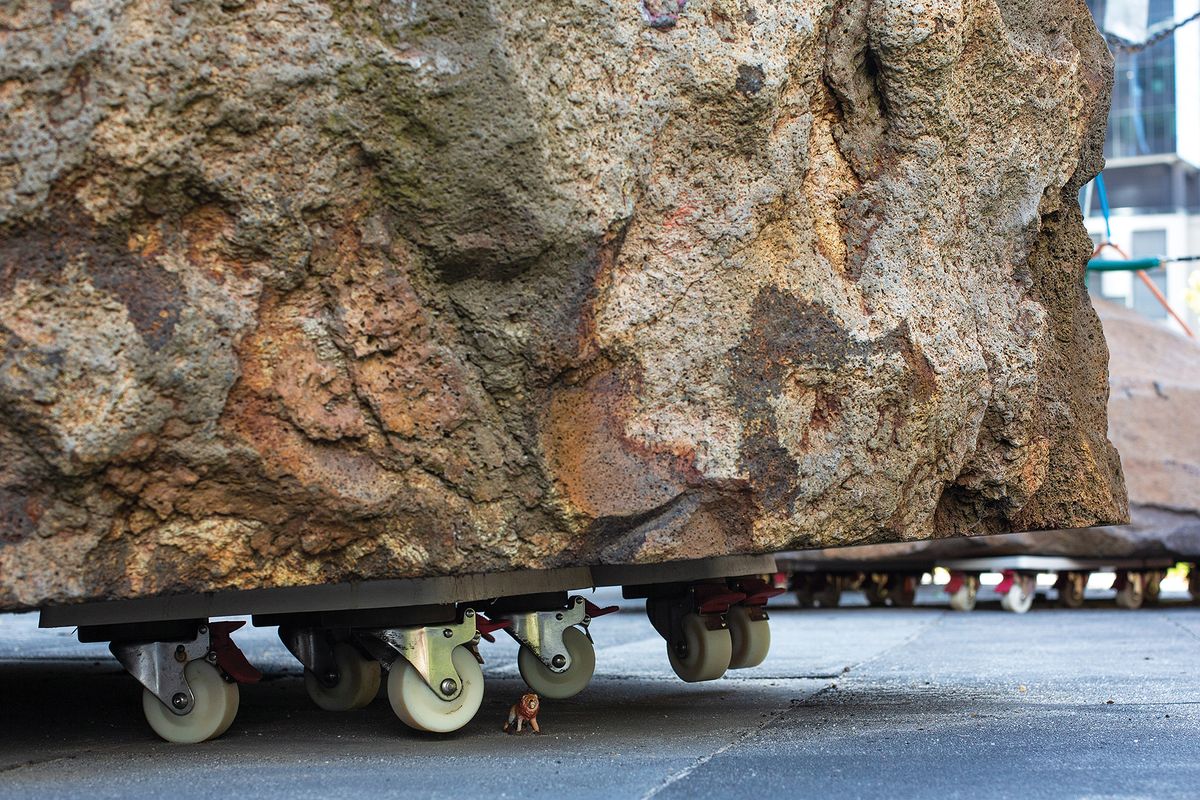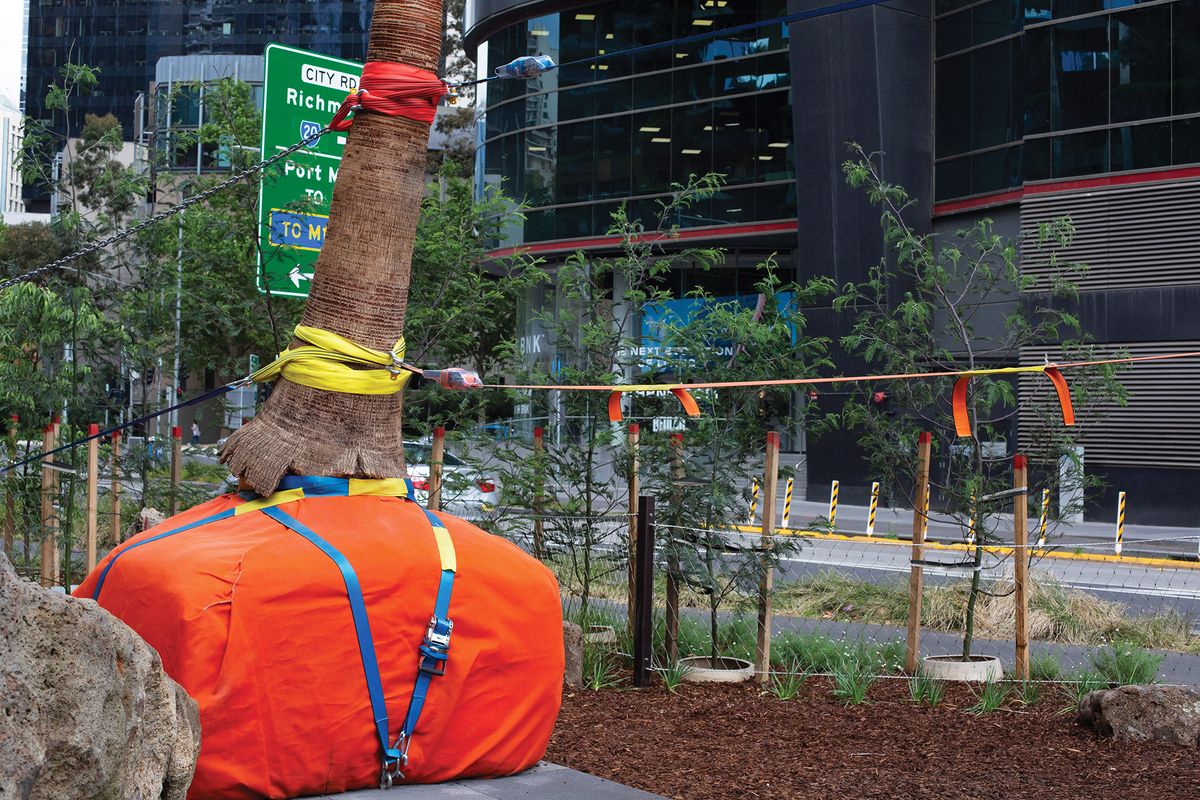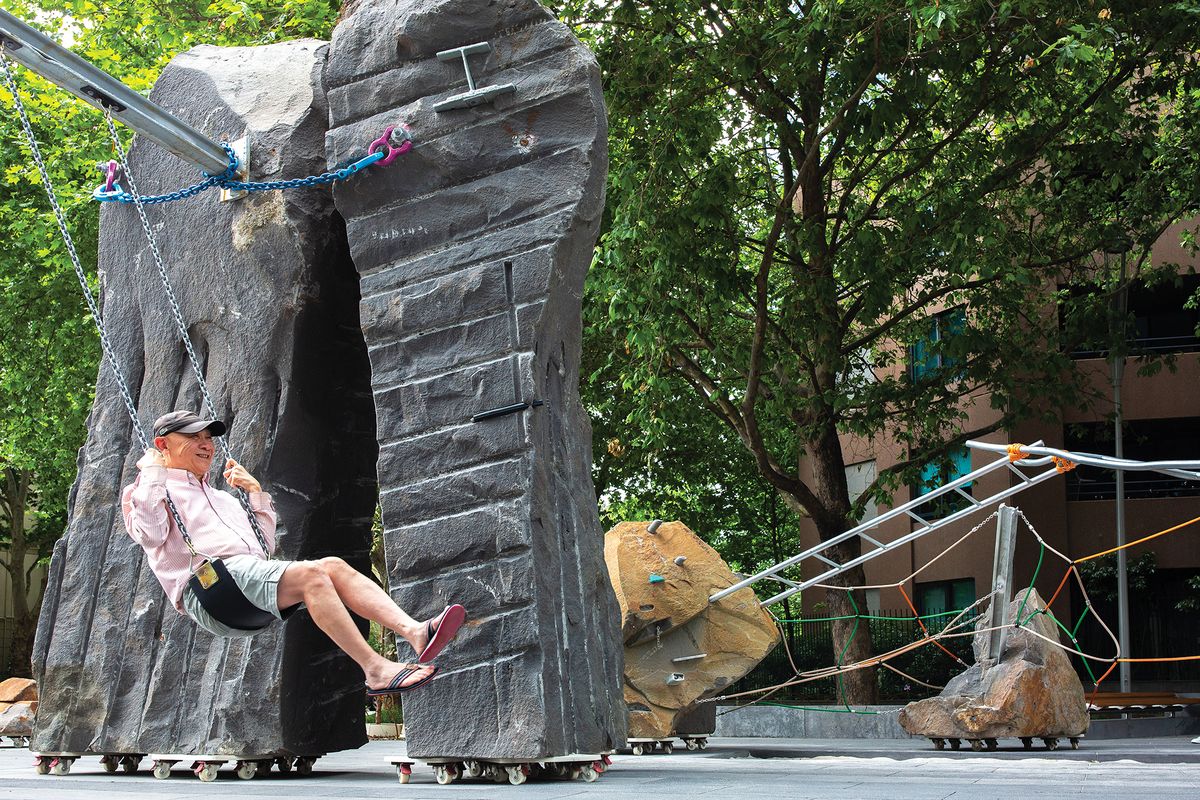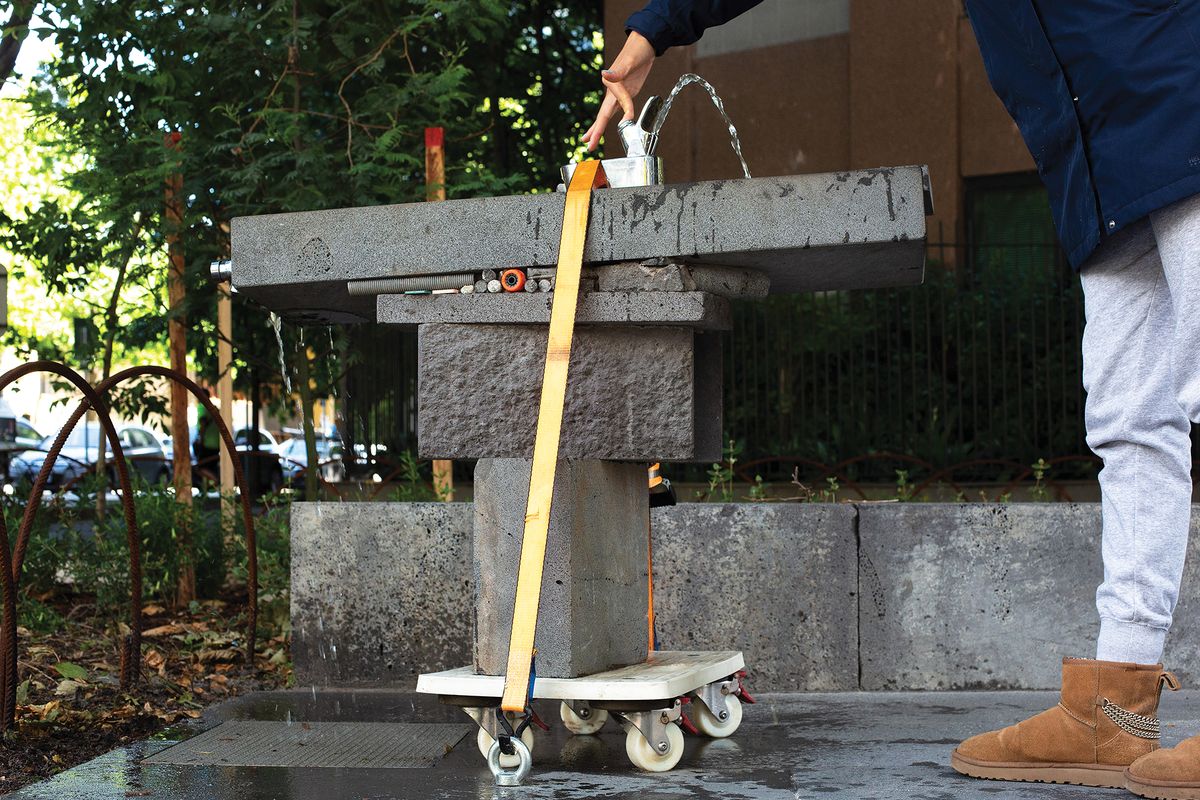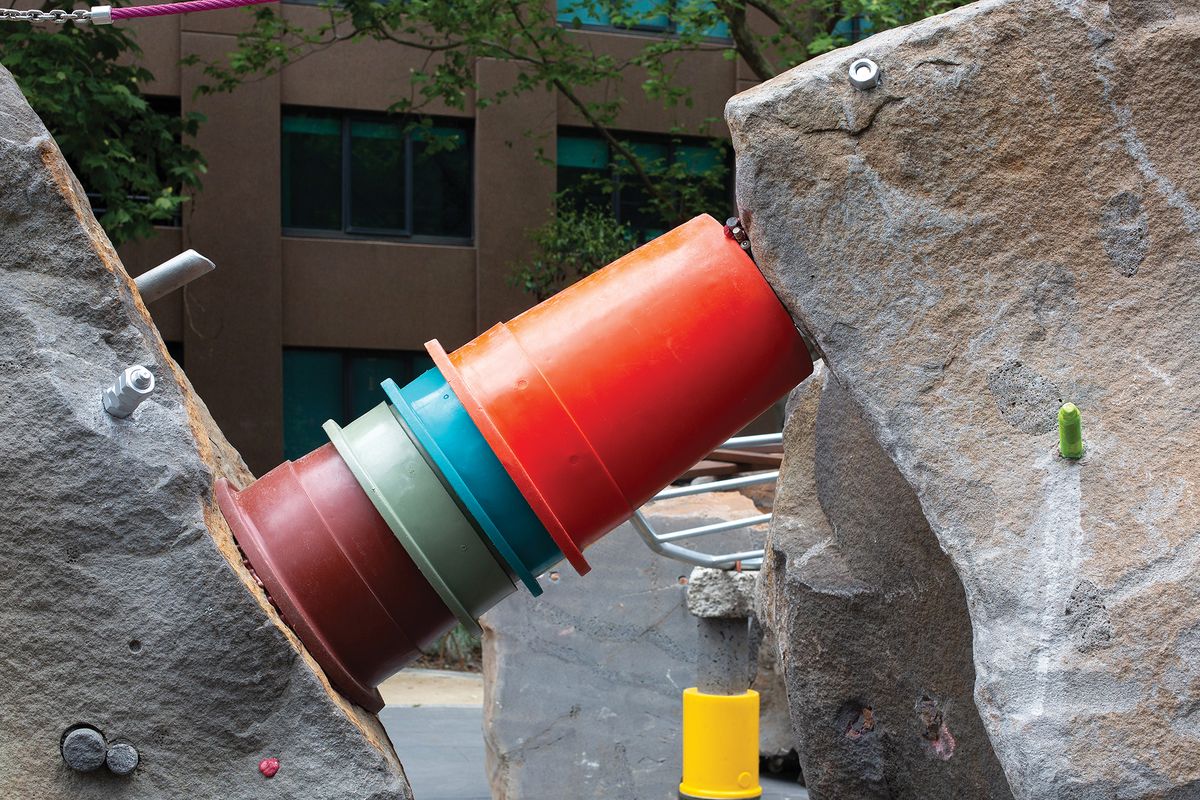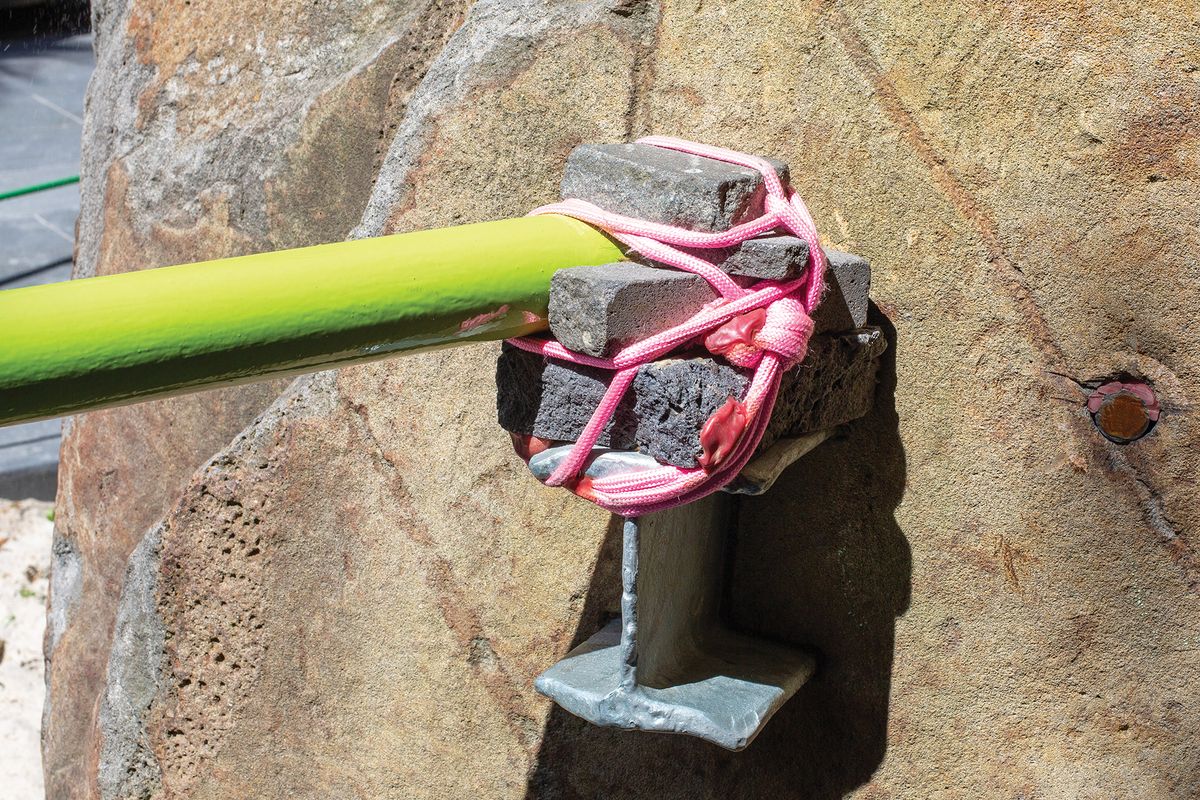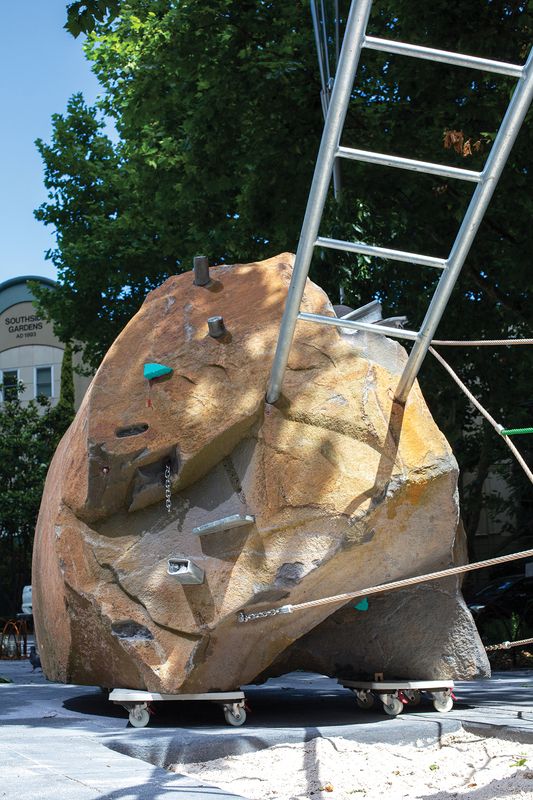Kiwi installation artist, engineer, subverter of public space, and bolo tie enthusiast Mike Hewson braved a rainy Melbourne summer day to show me around his recent project at Melbourne’s Southbank Boulevard, Rocks on Wheels. Nestled among the regular fabric of the city is something very irregular – I’ve yet to see a photo that captures the surreal vibe Hewson and City of Melbourne have created here.
The two dozen or so huge boulders are the first things you notice, and they seem to be alive, covered in barnacle-like handles and daubs of silicone. Standing between the giant stones feels like being at the zoo amid a cluster of strange animals paused, mid-scurry, on tiny castor toes. One rock seems to move out of the corner of my eye, and I hope they don’t stampede.
“[I wanted the arrangement to] look like someone, who doesn’t quite have permission, has just wheeled them in here,” Hewson says to a curious parent who has asked why the miniature wheels (that are fixed to the ground) are there.
The tactile surfaces and enchanting details of Rocks on Wheels appeal to visitors of all ages.
Image: Mike Hewson
In a touch of whimsy, miniature animals and toy cars have been dotted around the play space, peering out from beneath boulders.
Image: Mike Hewson
The playground’s ground plane retains the visual language of the City of Melbourne, but not everything is quite as it seems. As I move deeper into the site, what I had originally thought were standard bluestone pitchers turn out to be identical-looking rubber counterparts, a witty exercise in illusionism that contributes to the space’s surreal vibe. It’s a disarming feeling, stepping from the sidewalk’s firm and familiar bluestone onto these springy rubber blocks – a sense I’ve crossed a threshold into another world.
This feeling of immersion is made possible by Hewson’s extraordinary attention to detail, and the closer you look, the more you see. Bright orange grunt straps link to form a Bunnings-aesthetic slackline that runs from boulders to palm tree. A pile of building offcasts conceals a functional drinking fountain. And on top of one boulder, a tiny plastic castle reflects onto a puddle of water, not yet evaporated after this morning’s shower.
Bright orange grunt straps are linked to create a slackline with a humorous Bunnings-like aesthetic.
Image: Mike Hewson
Even on this rainy day, the space is packed. Kids squeal in delight, a few parents scaling the boulders with them. A retiree sitting on a bench looks up with a smile. Teenagers have been known to hang here in the evening, swinging from the ropes. The project, in other words, has been a roaring success. As Hewson and I perch on one of the benches, observing the flurry of activity, one parent says to us that the project is entirely different from the uninspiring playgrounds they feel have sprung up in recent years. I get their point – unlike more conventional playgrounds, this project embraces discovery and allows visitors to take risks; its tactile surfaces and enchanting details draw in both adults and children alike. And its aesthetic is very different to the proprietary play spaces most families have become accustomed to.
With this in mind, I ask Hewson about his process – and his response focuses not on how he accomplished the project, but on why it worked. With a series of successful projects already under his belt – his Illawarra Placed Landscape in Wollongong is a stand-out example – the council’s design team took him at his word when he agreed to follow the project through from initial vision (the design process began in 2018) through to ongoing stewardship. And this relationship of trust has been crucial to the project’s outcome. Rather than the usual landscape design and construction process that can result in a design vision being whittled down as it is passed through the hands of different studios from concept to construction, Hewson here has influenced every part of the project. This has included the conceptualization of the brief, all the way through to the selection and sourcing of boulders, the engineering of challenging elements and the design and crafting of the water fountain.
A drinking fountain at the play space comically resembles a pile of building offcuts precariously stacked for removal.
Image: Mike Hewson
Stacked plastic buckets are wedged between boulders, apparently serving as a precarious structural support.
Image: Mike Hewson
Jocelyn Chiew (Director City Design) and Kate Cudal (Design Manager and Principal Landscape Architect) at City of Melbourne were involved in the project as clients and leaders of the council’s design team. When I caught up with them later to hear their perspective, they agreed the project’s process was novel. In particular, the process required balancing the integrity of Hewson’s artistic vision with the requirements of the public realm. By being defined as both a play space and an artwork, Rocks on Wheels challenges the norms of both – and so did the project’s contract model, which allowed Hewson’s emergent input during each phase. The council’s landscape architecture and industrial design team was then deployed in response (to fine-tune components as they were being created, for example). As Hewson points out, this more flexible and responsive design process requires substantial trust and willingness to negotiate between parties, features not generally accommodated in the traditional contract delivery model.
Chiew is also keen to stress the significance of this design process on the built outcome. “When you give a project enough time to be designed through iteration,” she says, “the project doesn’t feel precious. People that visit it can feel liberated by the elements of the haphazard and the imperfect.”
This observation aligns with one of Hewson’s: “There’s a feeling of effortlessness [to the space] that is really important because it allows people to feel free to interact with it in any way they want,” he says.
I ask Chiew and Cudal whether they would deploy a similar design process in another project. Both are quick to say yes – and that they are already doing so on other projects. Chiew speaks about the outcome in glowing terms: “It’s unusual to have a play space that has value for everyone,” she says. “Rocks on Wheels is a place to meet, a place to entertain yourself or others, and a place for intellectual play for people of all ages. [The space is] non-commercialized and has not been designed for a select cohort, instead it’s about bringing people together, an anti-loneliness project.”
The play space was designed to be “an anti-loneliness project” that brings people of all ages together.
Image: Mike Hewson
It might be tempting to think this project exposes a failing of some parts of landscape architecture; while our profession regularly pumps out equipment-heavy play spaces with perfunctory customizations, someone from outside our field has made a real innovation. But we can’t all be Mike Hewsons. His combination of engineering nous and artistic vision is rare, and, as he’s careful to point out, an artist’s remit is different to that of a landscape architect. “Artists, we have a different set of goals and different ways of getting things done,” he says.
While artists have a longstanding tradition of challenging the public, landscape architects have different responsibilities and as a result can be hesitant about pushing boundaries. Cudal reiterates this point. “The thing about an artist is that you can’t separate the artist from the outcome – the work is intrinsically linked to the person and consequently there’s more room to be political. With that in mind, the tension [between artist and landscape architect] can be really productive,” she says.
For landscape architects as designers, and also for councils as clients, there is much in this project to be inspired by. First, this project might offer an improved model for integrating artists into landscape projects. The holistic and considered involvement of artists in landscape projects means making allowances for less linear, more process-driven design input, right from a project’s earliest phases: what Cudal describes as having “a really open mind and a willingness to allow for unexpected results.”
Even for projects that don’t have artists at their cores, Rocks on Wheels models an alternative design process suitable for public spaces. Longer time frames create room for creative solutions. Involving designers in the whole life cycle of a project, from shaping the brief to engaging with visitors at the site after it has opened, increases accountability and encourages stewardship. Perhaps councils would benefit from trusting more adventurous and emergent briefs to landscape architects who, like Hewson, have earned that trust.
Credits
- Project
- Rocks on Wheels (Southbank Boulevard Play Space)
- Design practice
- Mike Hewson
New Zealand
- Project Team
- The project is a collaboration across City of Melbourne with City Design (public realm design and integration with art work) and City Projects (project management).
- Design practice
- City of Melbourne
Melbourne, Vic, Australia
- Consultants
-
Foundation designer
Felicetti
Geological engineer Tonkin and Taylor
Heavy lift consultant Blake Hammon
Irrigation design Ten Buuren Irrigation Designs
Lighting designer Webb Australia Group
Play consultant Play DMC
Specialist fabrics ACT Shade
Structural engineer Event Engineering
- Site Details
- Project Details
-
Status
Built
Category Public / cultural
Type Playgrounds

